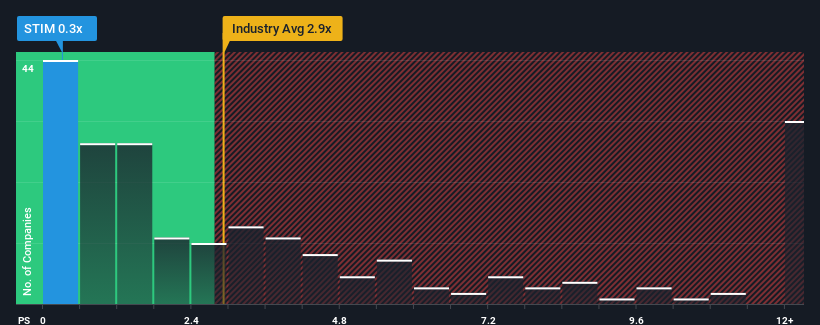- United States
- /
- Medical Equipment
- /
- NasdaqGM:STIM
Investors Give Neuronetics, Inc. (NASDAQ:STIM) Shares A 60% Hiding

The Neuronetics, Inc. (NASDAQ:STIM) share price has fared very poorly over the last month, falling by a substantial 60%. The recent drop completes a disastrous twelve months for shareholders, who are sitting on a 57% loss during that time.
Following the heavy fall in price, Neuronetics may look like a strong buying opportunity at present with its price-to-sales (or "P/S") ratio of 0.3x, considering almost half of all companies in the Medical Equipment industry in the United States have P/S ratios greater than 2.9x and even P/S higher than 6x aren't out of the ordinary. However, the P/S might be quite low for a reason and it requires further investigation to determine if it's justified.
Check out our latest analysis for Neuronetics

What Does Neuronetics' P/S Mean For Shareholders?
Neuronetics' revenue growth of late has been pretty similar to most other companies. One possibility is that the P/S ratio is low because investors think this modest revenue performance may begin to slide. If not, then existing shareholders have reason to be optimistic about the future direction of the share price.
If you'd like to see what analysts are forecasting going forward, you should check out our free report on Neuronetics.What Are Revenue Growth Metrics Telling Us About The Low P/S?
There's an inherent assumption that a company should far underperform the industry for P/S ratios like Neuronetics' to be considered reasonable.
If we review the last year of revenue growth, the company posted a worthy increase of 10%. This was backed up an excellent period prior to see revenue up by 46% in total over the last three years. So we can start by confirming that the company has done a great job of growing revenues over that time.
Looking ahead now, revenue is anticipated to climb by 13% each year during the coming three years according to the four analysts following the company. Meanwhile, the rest of the industry is forecast to only expand by 9.5% per year, which is noticeably less attractive.
With this in consideration, we find it intriguing that Neuronetics' P/S sits behind most of its industry peers. Apparently some shareholders are doubtful of the forecasts and have been accepting significantly lower selling prices.
The Key Takeaway
Neuronetics' P/S looks about as weak as its stock price lately. Typically, we'd caution against reading too much into price-to-sales ratios when settling on investment decisions, though it can reveal plenty about what other market participants think about the company.
A look at Neuronetics' revenues reveals that, despite glowing future growth forecasts, its P/S is much lower than we'd expect. When we see strong growth forecasts like this, we can only assume potential risks are what might be placing significant pressure on the P/S ratio. While the possibility of the share price plunging seems unlikely due to the high growth forecasted for the company, the market does appear to have some hesitation.
Don't forget that there may be other risks. For instance, we've identified 4 warning signs for Neuronetics (1 is potentially serious) you should be aware of.
It's important to make sure you look for a great company, not just the first idea you come across. So if growing profitability aligns with your idea of a great company, take a peek at this free list of interesting companies with strong recent earnings growth (and a low P/E).
Valuation is complex, but we're here to simplify it.
Discover if Neuronetics might be undervalued or overvalued with our detailed analysis, featuring fair value estimates, potential risks, dividends, insider trades, and its financial condition.
Access Free AnalysisHave feedback on this article? Concerned about the content? Get in touch with us directly. Alternatively, email editorial-team (at) simplywallst.com.
This article by Simply Wall St is general in nature. We provide commentary based on historical data and analyst forecasts only using an unbiased methodology and our articles are not intended to be financial advice. It does not constitute a recommendation to buy or sell any stock, and does not take account of your objectives, or your financial situation. We aim to bring you long-term focused analysis driven by fundamental data. Note that our analysis may not factor in the latest price-sensitive company announcements or qualitative material. Simply Wall St has no position in any stocks mentioned.
About NasdaqGM:STIM
Neuronetics
A commercial stage medical technology company, designs, develops, and markets products for patients with neurohealth disorders in the United States and internationally.
Slight and fair value.

